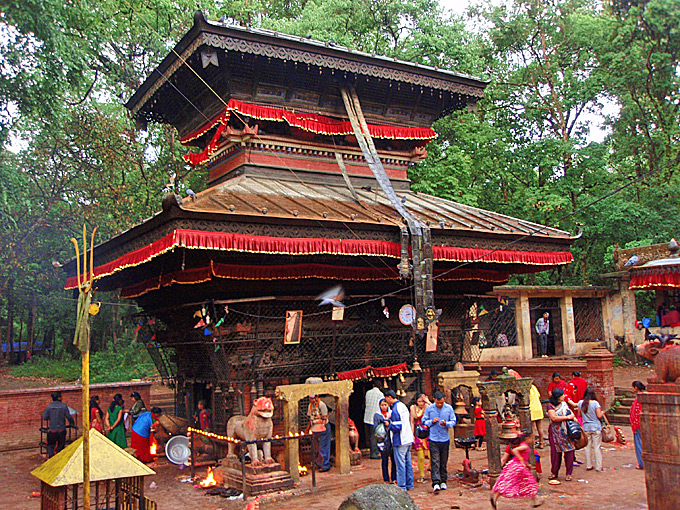This is the temple of the boar headed Goddess on a human body who is commonly known as Barahi. Bajra stands for a mythical sword of lightning and thunder. She is also considered to be a Matrika, a name given a group of seven or sometimes eight Mother Goddesses. She is regarded as the personification of feminine powers of all male and female Gods of Hinduism. She is worshipped by Buddhists as well, and the name Bajra Barahi in its entirety is used mostly by Buddhists.
Like so many ancient temples, most of their historical data are better recorded in family genealogies of a priest or influential families of the day. Many of such inscriptions are lost in time, mainly due to negligence and sometimes loot or vandalism. No such inscription exists today that recorded detailed information on the temple. From genealogical accounts, it can be confirmed that the temple construction was initiated in the year 786 Nepal Sambat (1666 A.D.). The day was a Monday in the month of Chaitra.
It is mentioned that King Shree Niwas Malla from Patan built the temple. The location of the temple had a small pond from where Goddess Bajra Barahi first appeared and over time the pond dried up, as per folk tales.
Chapagaon & Bajra Barahi Temple
Historical records tell that a town was established in the year 500 Nepal Sambat (1380 A.D.). A damaged stone inscription and another one from a small temple of Lord Krishna confirm the fact. A newborn prince from Bhaktapur officially inherited the town that was a growing trading post in North-South trading route connecting India with Tibet, a small portion of the infamous Silk Route. The young prince was born in an extremely inauspicious occasion and hence was deemed to exile, as commonly happened to many such newly born. Late Crown Prince Dipendra who apparently assassinated his whole family including the King and Queen, was said to have been born in a similar inauspicious occasion. Such practices were fairly common in many conservative parts of Nepal even three decades ago. Usually, such child were given to travelling sages even before fathers get to see their infant’s face.
Since King Raj Dev Malla was forbidden to ever see his again; he officially handed over the town to the son and dispatched a whole set of aristocrats, priests, courtiers, workers, smiths, potters, and soldiers along rest of the entourage to help his son rule the town. A stone inscription confirms that the two was officially re-established as a state in 711 Nepal Sambat (1591 A.D.).
In ancient days when religious beliefs every aspects of people and ruler’s lives, lack of a protector deity was felt. As local folklores claimed that Goddess Bajra Barahi had appeared from a location, just east of town, a temple would eventually be commissioned there.
The Temple
After the temple was constructed, records also show that the locals used the vicinity for cremations, a practice later forbidden by visiting King’s orders. The cremation decks still exist, nine of them actually. The records also mention that the temple was being built at unusually quickly for the day. In the last 6 decades, many heritages throughout the country were stolen; many struts along with the main statue of the temple were stolen. After much investigation, the authorities were able to recover thee main statue. It has since been kept safe in Nepal Army Museum in Chhauni, Kathmandu. The current statue in the temple is an alternative one. Locals also believe that fallen woods and leaves from the forest should remain there, if they are brought outside the temple zone, the person will be cursed.

(Photo: snatalya.livejournal.com)







